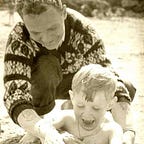Why you need to be inspired to solve problems.
Where do you get yours?
If you take a look at IDEO’S HUMAN CENTERED DESIGN BOOK not only will you find 57 design methods that you could use in your practice but also information on mindsets needed to solve complex problems, examples of how human centered design is used to solve for problems in the field and more. The methodology framework that the book discusses is simple and has 3 phases.
INSPIRATION — observing and understanding
IDEATION- idea generation
And IMPLEMENTATION — bringing the solution to life
Getting inspired is a huge part of the problem solving process- if you are not inspired to solve a problem it can be hard to come up with ideas for solutions.
When I facilitate workshops or am working with my high school and graduate students, I talk about inspiration and ask, “What inspires you?”. When I begin class, I often share an example of something that inspired me, and I ask them to share their inspirations. Everyone is inspired differently. For some of us it is going to art galleries or museums. For others it’s reading books, magazines, or journals. Maybe a movie? Maybe we are inspired by our students or friends? Or an adventure to a new place or a place you haven’t been in a while.
A few weeks ago I went to Coney Island on the subway with my Irish friend and brilliantly talented Sheila O’Shea, a music teacher from The School at Columbia University. Sheila frequently goes to Coney Island to swim, I on the other hand, hadn’t been there in 20 years! While walking on the boardwalk, I watched people, sat outside in a restaurant and took in the sand and ocean, and pondered the physics behind the rides in the amusement park. It opened my eyes to a whole side of New York I had forgotten about — it inspired me to revisit neighborhoods I had not been to in a while. Every few weeks I try to pick a neighborhood in the city, explore it and see what might inspire me.
I was also inspired recently by watching “Watch The Sound with Mark Ronson”. This documentary explores how electronic music is created and what producers and creators are willing to do to find the perfect sound; it also explores the intersection of music, technology, and creativity.
The first episode tells the story of “AutoTune” an audio processor introduced by Andy Hildebrand, CEO, Antares Audio Technologies, which uses a proprietary device to measure and alter pitch in vocal and instrumental music recording and performances. It essentially finds the perfect tune of a voice so nothing is ever off pitch.
Hilderbrand, a geophysicist who worked for Exxon, developed a technique called autocorrelation for interpreting waves when prospecting for oil underground using sound waves. (This is a brilliant example of innovation–taking something designed to solve one type of problem, and reframing it to solve another). Mark Ronson is a genius and deeply passionate about music and the artists he produces. This documentary series blew my mind and truly inspired me. I have been using my experience with Watch the Sound to help my students understand innovation, by giving them examples of innovation that I learned while watching the series.
Think about what inspires you, chase it, and see how it helps you solve complex problems.
